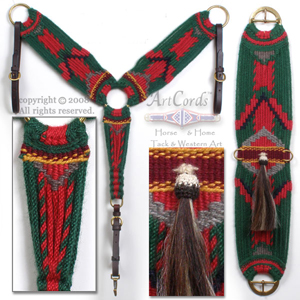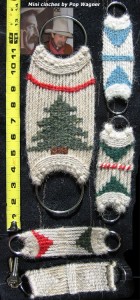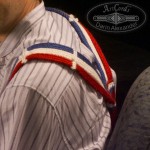Have you ever considered how the traditional techniques of cinch making could be employed to create a seasonal theme? For many of us cinch makers such possibilities are great opportunities to stretch our creativity and further refine our proficiency of technique.
While many have asked,”why make cinches by hand, aren’t they made by machine?!” The truth is quite the opposite… the complexity of cinch making is such that no machine has yet been developed to automate the cinch making process. The reasons for such inquiries and fact that such a machine does not exist will be best discussed at another time… we just want folks to be clear that a good part of the value of ornate cinch making is that they require human creativity and practice to gain the skills.
Upon closer inspection of different cinches you may begin to notice that various techniques are used. There are many possibilities for such variations. On the one hand you have those who only make a cinch the way they were originally taught because it is the only way they know. On the other hand, there is a growing movement of principle based craftsmanship which shifts focus from cheap functionality to the more refined forms of optimal comfort of horse or mule. This extra effort of refinement has introduced a new era of more elegant flair and graceful form providing folks with a visual invitation to consider the comfort and health relating to cinches.
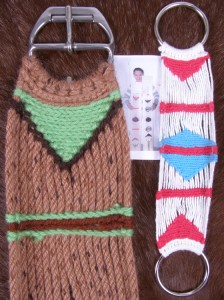
At age 79 Richard Cervantes has returned to the art of cord cinch making which he learned as a youth.
There is a growing number of folks making the connection between softer cinches of 100% animal fibers and improved behavior of horse and mule. With the industrial trend away from natural animal fibers due largely to more labor intensive and slower processes required to make the cinch cords, folks are going to great lengths in searching for real mohair and alpaca cinches. A growing number of consumers are discovering that learning to make quality cinches is an available option. Learning to make your own cinches is especially attractive given the considerations of cinch width and length which can be optimized when one is familiar with their own preference of rigging positions and variations of horse or mule confirmation.
Among those who have already learned the trade, there are a good number of us who learned the ropes of cinch making as youth. One such maker, returning to cinch making at age 79, shared with us how he remembers the “goat hair” cinch cords first being plied up from smaller yarns that were also used to make mecates. One of the standard style cinchas, which he made on a regular basis as a youngster, had a white body with red and blue detailing. Upon getting back into cinch making, he has found it enjoyable to fashion items with cinch design out of any materials easily accessible for use as wall hangings and smaller ones for key-chains.
A Minnesota native, widely traveled with his talents as a rope twirler, musician, and cowboy humorist, took up the ropes of cinch making following participation in a class I taught at the 2006 “Cowboy Songs” symposium in Cody, Wyoming. His subsequent purchase of our DVDs is the only other cinch training he obtained, providing a good foundation for custom cinches he offers.
A theme highlight of Pop Wagner’s cinch making was the making of Christmas tree ornaments for the Capital Christmas tree in 2010. The ornaments were quite welcome as fitting the emphasis on Wyoming since the Big Tree was delivered to Washington D.C. from Jackson Hole vicinity of northwest Wyoming.
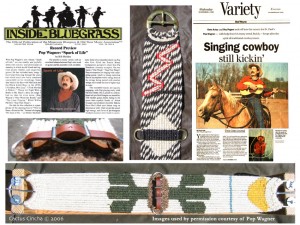
Mohair Cinch Making enthusiast, Pop Wagner, first learned the art of cord cinches from Darin Alexander in 2006.
For those who have an interest in cinch making there are a few ways to get started: (owning a horse or mule is not required!)
- Study various cinches and learn through trial and error on your own.
- Purchase Mr. Alexander’s Cinch Making 101 DVD from our authorized dealer, Eclectic Horseman… Good information for anyone involved with horseback riding since we discuss considerations for choosing materials and function/use of cinches. My personal teaching style is to share obscure reasons intertwined in various techniques and offer pointers on how to avoid painful mistakes.
You may also be interested to learn that the cinch techniques are not limited to cinches only. Experiment and become more proficient with cinch making techniques through use of the methods for any number of other items which can be created out of cords. The sky is hardly the limit when contemplating possible ways to employ these cowboy cordage techniques. Seasonal and patriotic color schemes can be fashioned into such things as suspenders, belts, and hat bands too!
The beauty of classes, video and personal training is how you gain a point of reference, often saving you much time and frustration of trying to figure things out by trial and error. Another benefit of quality instruction is that we share suggestions and pointers on ways to focus or expand your personal direction. It could be that as the number of quality cinch makers grow, the more opportunity for collaborative efforts and availability of improved or new items.
So from us to you, here is wishing the best of the holiday season and food for your 2012 creativity thoughts…
- This site and the ongoing provision of public educational opportunities through ArtCords are a direct result of the generous gesture of visitors like you. We appreciate your participate in our efforts for the Equine’s sake.
Thank you for telling others of our educational efforts!

